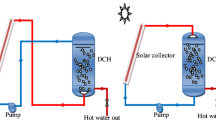Abstract
In most direct contact liquid-liquid heat exchangers, oil or hydrocarbon with a density less than water is normally used as dispersed working fluid. The main difficulty that arises with this arrangement lies in the control of the interface at the top of the column. When it is closely connected with a solar collector which uses water as its working fluid, the main difficulties arise from the fact that the water can be frozen during winter time. In order to solve these problems and to demonstrate the technical feasibility of a direct contact liquid-liquid heat exchanger, liquids heavier than water with low freezing temperature has been utilized as dispersed phase liquids in a small laboratory scale model made out of pyrex glass. In the present investigation, dimethyl phthalate (C6H4(COOCH3)2) and diethyl phthalate (C6H4(CO2C2H5)2) are utilized as heavy dispersed phase working fluids. The results of the present investigation support the technical feasibility in the utilization of heavier dispersed working liquid in the spray column liquid-liquid heat exchanger for a solar system. The overall average temperature difference along the column is found to be almost half of the intial temperature difference between the dispersed and the continuous phase. Despite the fact that the two phthalates tested in the experiment differ significantly in some of their physical properties, the volumetric heat transfer coefficients in terms of dispersed fluid superficial velocities were found to be similar for both phthalates tests.
Similar content being viewed by others
Abbreviations
- a :
-
Interfacial area per unit volume, cm−1
- A :
-
Area through which heat transfer occurs, cm2
- F/S :
-
Superficial velocity of the dispersed phase liquid, cm/sec
- h c :
-
Continuous phase (water) heat transfer coefficient, J/(sec)(cm2)(°C)
- h d :
-
Dispersed phase heat transfer coefficient, J/(sec)(cm2(°C)
- k :
-
Thermal conducitivity, (W cm)/°K
- H :
-
The fraction of the effective volume of the heat exchanger occupied by the dispersed phase (holdup), dimensionless
- L :
-
Vertical height of the continuouse phase (water) in the heat exchanger, cm
- N N :
-
Nusselt number=h d/k, dimensionless
- N p :
-
Prandtl number=c μ/k, dimensionless
- N pe :
-
Peclet number=c ρ V d/k=N p N R , dimensionless
- N R :
-
Reynolds number=d V ρ/μ, dimensionless
- N s :
-
Stanton\(number = \frac{U}{{C_d \rho _d F/S}}\), dimensionless
- Q :
-
Rate of the heat transfer, J/sec=W
- S :
-
Horizontal cross sectional area of the heat exchanger, cm2
- ΔT 1 :
-
Initial temperature difference, °C
- T i :
-
Temperature measured in the column, °C
- T c :
-
Temperature of the continuous phase liquid (water), °C
References
Golafshani, M. and Jacobs, H. R., 1985, “Stability of a Direct Contact Spray Column Heat Exchanger,”ASME/AIChE National Heat Transfer Conference, Denver, ASME Paper 85-HT-51.
Handlos, A. E. and Baron, T., 1957, “Mass and Heat Transfer from Drops in liquid-Liquid Extraction,”A.I.Ch.E Journal, Vol. 3, No. 1, pp. 127–136.
Harvath, M., 1976, “Hydrodynamik und Stoffaustausch in einer Flussing-Flussing-Spruhkolonne,” Ph. D. Thesis, ETH, Zurich, Switz.
Jacobs, H. R. and Golafshani, M., 1985, “A Heuristic Evaluation of the Governing Mode of Heat Transfer in a Liquid-Liquid Spray Column,”ASME/AIChE National Heat Transfer Conference, Denver, ASME Paper 85-HT-50.
Moresco, L. L. and Marschall, E., 1980, “Liquid-Liquid Direct Contact Heat Transfer in a Spray Column,”Transaction of the ASME, Vol. 102, November, pp. 684–686.
Stamps, D. W., Barr, D. and Valenzuela, J. A., 1986, “A Model of Heat Transfer in a Liquid-Liquid Spray Column,”Journal of Heat Transfer, Vol. 108, pp. 488–489.
Steiner, L. and Hartland, S., 1983, “Hydrodynamics of Liquid-Liquid Spray Columns,”in Handbook of Fluid in Motion (Edited by cheremisinoff, N. P. and Gupta, R.), Ann Arbor Science Publishers, Michigan., pp. 1049–1092.
Ward, J. C., Loss, W. M. and George, O. G., 1977, “Direct Contact Liquid-Liquid Heat Exchanger for Solar Heated and Cooled Building,” Solar Energy Application Laboratory, Colorado State University, coo/2867-2.
Author information
Authors and Affiliations
Rights and permissions
About this article
Cite this article
Kang, I.S., Kim, C.B. & Chun, W.G. Liquid-liquid direct contact heat exchanger for solar application. KSME Journal 9, 19–28 (1995). https://doi.org/10.1007/BF02954351
Received:
Issue Date:
DOI: https://doi.org/10.1007/BF02954351




